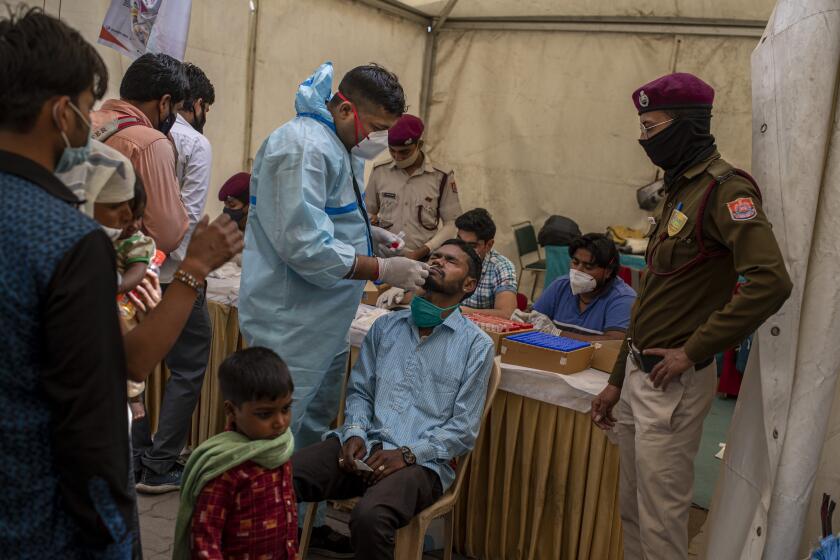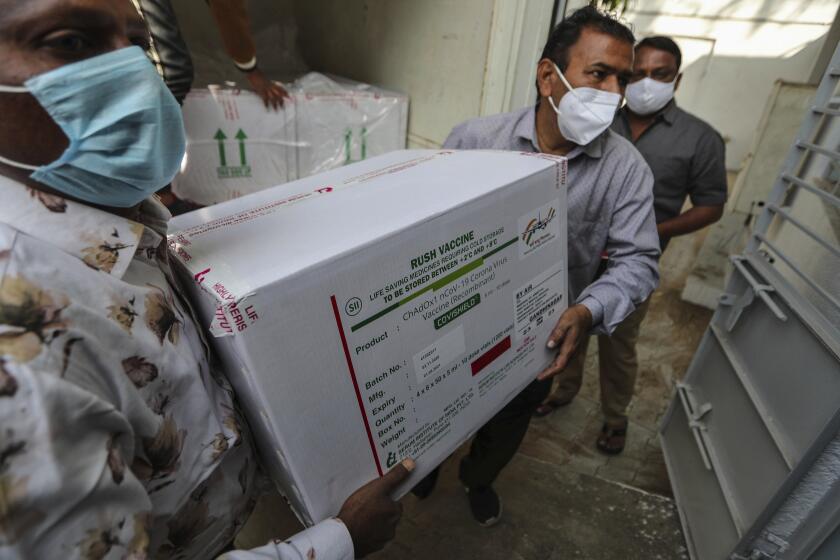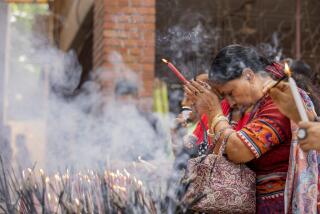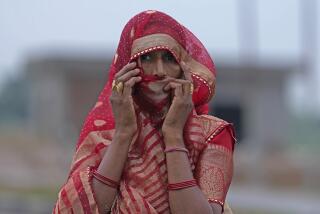Huge crowds at Hindu festival as India becomes 2nd-worst-hit country of the pandemic
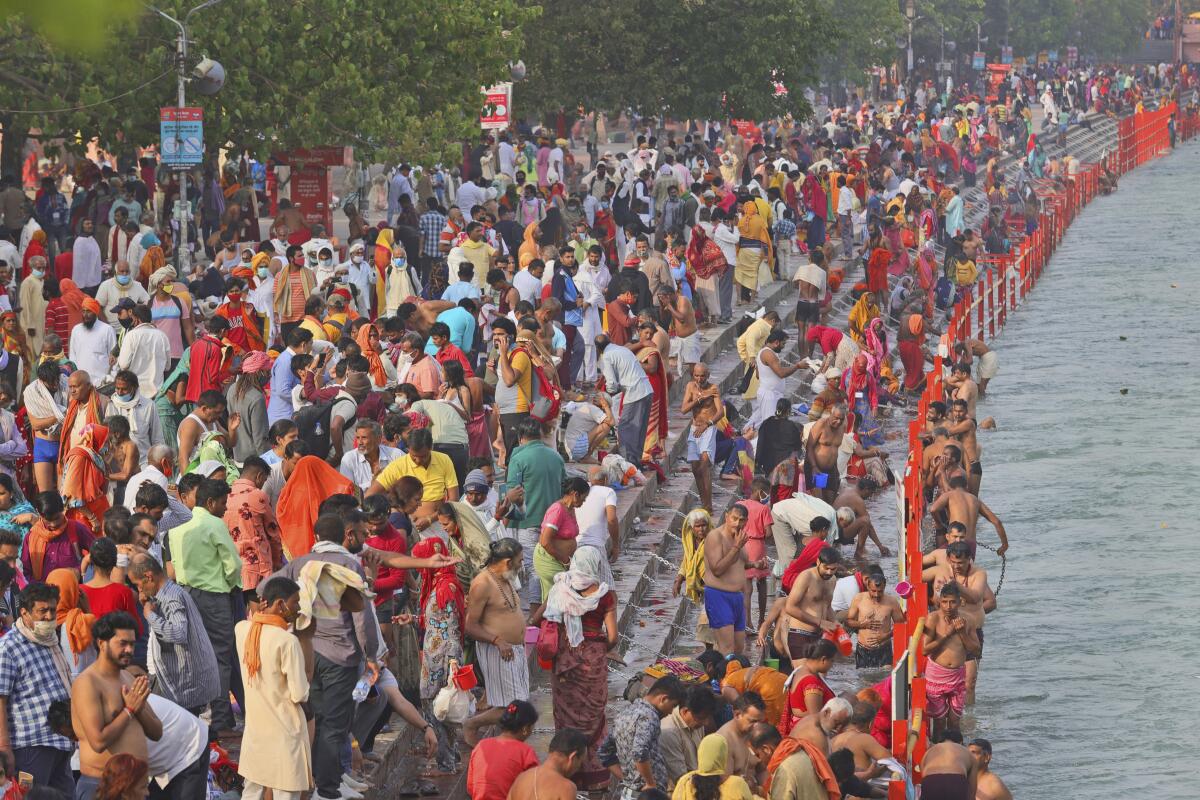
- Share via
NEW DELHI — Tens of thousands of Hindu devotees gathered by the Ganges River for special prayers Monday, many of them flouting social-distancing practices even as a record surge in coronavirus cases pushed India past Brazil as the world’s second-worst-hit country in the world.
The Kumbh Mela, or pitcher festival, is one of the most sacred pilgrimages in Hinduism. The faithful congregate in the northern city of Haridwar and take a dip in the waters of the Ganges, which they believe will absolve them of their sins and deliver them from the cycle of birth and death.
The Kumbh Mela, which runs through April, comes during India’s worst surge in new infections since the COVID-19 pandemic began, with a seven-day rolling average of more than 130,000 new cases per day. Hospitals are becoming overwhelmed with patients, and experts worry that the worst is yet to come.
Critics of Prime Minister Narendra Modi and his Hindu-nationalist Bharatiya Janata Party say the festival has been allowed at a time when infections are skyrocketing because the government isn’t willing to anger Hindus, who are the party’s biggest supporters.
With the surge showing no sign of slowing, India’s confirmed infections since the pandemic began surpassed Brazil’s total Monday to make it the second-worst-hit country in the world, with 13.5 million cases, according to Johns Hopkins University.
The current surge has hit hardest in Western Maharashtra state, home to the financial capital, Mumbai. The state has accounted for nearly half of the country’s new infections in the past two weeks.
Most virus mutations are trivial, but scientists are investigating which ones might make the virus spread more easily or make people sicker.
Despite concerns that the Kumbh Mela festival could turn into a superspreader event, Uttarakhand state’s chief minister, Tirath Singh Rawat, said last week that “faith in God will overcome the fear of the virus.”
Health experts had appealed for the festival to be canceled, but the government went ahead, saying safety rules would be followed. There are concerns that pilgrims could get infected and then take the virus back to their cities and villages in other parts of the country.
Authorities in Haridwar said the length of the festival had been shortened from previous years, but it has been extremely difficult to implement social-distancing measures. Coronavirus tests are mandatory for those entering the area.
“We are continuously appealing to people to follow COVID-19-appropriate behavior. But due to the huge crowd, it is practically not possible,” said Sanjay Gunjyal, a senior police officer.
Doubts surrounding a homegrown vaccine are among the challenges facing India’s effort to vaccinate 300 million people in six months.
Critics have compared the government’s response to the festival to the response last year when Indian Muslims faced rising Islamophobia following accusations that an initial surge in infections was tied to a three-day meeting of an Islamic missionary group, the Tablighi Jamaat, in New Delhi.
Some leaders from Modi’s party and India’s freewheeling TV channels, which have long favored the government’s Hindu-nationalist policies, labeled Muslims as “jihadis” and “superspreaders” in March 2020, a time when the seven-day rolling average of coronavirus cases in the country was not even 200 per day. The blame triggered a wave of violence, business boycotts and hate speech toward Muslims.
India’s 200 million Muslims account for 14% of the population and are the largest minority group in the Hindu-majority nation.
The surge in India comes as the country’s vaccination drive appears to be struggling. Multiple Indian states have reported a shortage of doses even as the federal government has insisted that there’s enough stock.
After a sluggish start, India is now vaccinating 3.6 million people on average daily, which is more than the United States. It has so far administered more than 103 million shots, the most in the world after the U.S. and China but much lower than many countries per capita — still less than 6% of India’s population of nearly 1.4 billion people.
More to Read
Sign up for Essential California
The most important California stories and recommendations in your inbox every morning.
You may occasionally receive promotional content from the Los Angeles Times.
